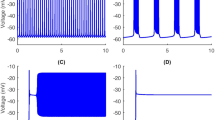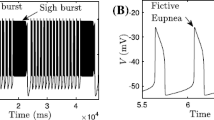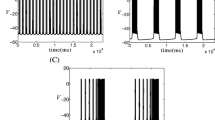Abstract
A mathematical model of burster neuron R15 from the abdominal ganglion of Aplysia is presented. This is an improvement over earlier models in that the bursting mechanism is more accurately represented. The improved model allows for simulated application of the neurotransmitter serotonin, which has been reported to have profound effects on the voltage waveform produced by R15. Computational analysis indicates that the serotonin-induced modulation of the waveform can be explained in terms of competition between stationary, bursting, and beating attractors. Analysis also indicates that, as a result of this competition, serotonin increases the sensitivity of the neuron to synaptic perturbations. This may have important consequences with regard to water balance in the Aplysia, particularly during egg laying.
Similar content being viewed by others
References
Adams DJ, Gage PW (1979a) Ionic currents in response to membrane depolarization in an Aplysia neurone. J Physiol (Lond) 289:115–141
Adams DJ, Gage PW (1979b) Characteristics of sodium and calcium conductance changes produced by membrane depolarization in an Aplysia neurone. J Physiol (Lond) 289:143–161
Adams WB (1985) Slow depolarizing and hyperpolarizing currents which mediate bursting in Aplysia neurone R15. J Physiol (Lond) 360:51–68
Adams WB, Benson JA (1985) The generation and modulation of endogenous rhythmicity in the Aplysia bursting pacemaker neuron R15. Prog Biophys Mol Biol 46:1–49
Adams WB, Benson JA (1989) Rhythmic neuronal burst generation: experiment and theory. In: Goldbeter A (ed) Cell to cell signalling: from experiments to theoretical models. Academic Press, London, pp 29–45
Adams WB, Levitan IB (1985) Voltage and ion dependences of the slow currents which mediate bursting in Aplysia neurone R15. J Physiol (Lond) 360:69–93
Adams WB, Parnas I, Levitan IB (1980) Mechanism of long-lasting synaptic inhibition in Aplysia neuron R15. J Neurophysiol 44:1148–1160
Baimbridge KG, Miller JJ, Parkes CO (1982) Calcium-binding protein distribution in the rat brain. Brain Res 239:519–525
Barrett JN, Magleby KL, Pallotta BS (1982) Properties of single calcium-activated potassium channels in cultured rat muscle. J Physiol (Lond) 331:211–230
Benson JA, Levitan IB (1983) Serotonin increases an anomalously rectifying K+ current in the Aplysia neuron R15. Proc Natl Acad Sci USA 80:3522–3525
Byerly L, Hagiwara S (1982) Calcium currents in internally perfused nerve cell bodies of Limnaea stagnalis. J Physiol (Lond) 322:503–528
Canavier CC, Clark JW, Byrne JH (1991) Simulation of the bursting activity of neuron R15 in Aplysia: role of ionic currents, calcium balance, and modulatory transmitters. J Neurophysiol 66:2107–2124
Carpenter DO, McCreery MJ, Woodbury CM, Yarowsky PJ (1978) Modulation of endogenous discharge in neuron R15 through specific receptors for several transmitters. In: Chalazonitis N, Boisson M (eds) Abnormal neuronal discharges. Raven Press, New York, pp 189–203
Chay TR, Keizer J (1983) Minimal model for membrane oscillations in the pancreatic β-cell. Biophys J 42:181–190
Connor JA, Stevens CF (1971) Prediction of repetitive firing behavior from voltage clamp data on an isolated neurone soma. J Physiol (Lond) 213:31–53
Doedel EJ (1981) AUTO: a program for the automatic bifurcation and anslysis of autonomous systems. Congr Numerantium 30:265–284
Drummond AH, Benson JA, Levitan IB (1980) Serotonin-induced hyperpolarization of an identified Aplysia neuron is mediated by cyclic AMP. Proc Natl Acad Sci USA 77:5013–5017
Gorman ALF, Thomas MV (1980) Potassium conductance and internal calcium accumulation in a molluscan neurone. J Physiol (Lond) 308:287–313
Gorman ALF, Hermann A, Thomas MV (1982) Ionic requirements for membrane oscillations and their dependence on the calcium concentration in a molluscan pace-maker neurone. J Physiol (Lond) 327:185–217
Hille B (1984) Ionic channels of excitable membranes. Sinauer Associates, Sunderland, Mass
Hindmarsh JC, Rose RM (1984) A model of neuronal bursting using three coupled first order differential equations. Proc R Soc Lond [Biol] 221:87–102
Hodgkin AL, Huxley AF (1952) A quantitative description of membrane current and its application to conduction and excitation in nerve. J Physiol (Lond) 117:500–544
Junge D, Stephens CL (1973) Cyclic variation of potassium conductance in a burst-generating neurone in Aplysia. J Physiol (Lond) 235:155–181
Kandel ER (1979) Behavioral biology of Aplysia. Freeman, San Francisco, p 324
Kramer RH, Zucker RS (1985a) Calcium-dependent inward current in Aplysia bursting pace-maker neurones. J Physiol (Lond) 362:107–130
Kramer RH, Zucker RS (1985b) Calcium-induced inactivation of calcium current causes the inter-burst hyperpolarization of Aplysia bursting neurones. J Physiol (Lond) 362:131–160
Levitan ES, Levitan IB (1988) Serotonin acting via cyclic AMP enhances both the hyperpolarizing and depolarizing phases of bursting pacemaker activity in the Aplysia neuron R15. J Neurosci 8:1152–1161
Levitan ES, Kramer RH, Levitan IB (1987) Augmentation of bursting pacemaker activity by egg-laying hormone in Aplysia neuron R15 is mediated by a cyclic AMP-dependent increase in Ca2+ and K+ currents. Proc Natl Acad Sci USA 84:6307–6311
Lewis DV (1984) Spike aftercurrents in R15 of Aplysia: their relationship to slow inward current and calcium influx. J Neurophysiol 51:387–403
Lewis DV (1988) Calcium-activated inward spike after-currents in bursting neurone R15 of Aplysia. J Physiol (Lond) 395:285–302
Lewis DV, Evans GB, Wilson WA (1984) Dopamine reduces slow outward current and calcium influx in burst-firing neuron R15 of Aplysia. J Neurosci 4:3014–3020
Lotshaw DP, Levitan ES, Levitan IB (1986) Fine tuning of neuronal electrical activity: modulation of several ion channels by intracellular messengers in a single identified nerve cell. J Exp Biol 124:307–322
Mathieu PA, Roberge FA (1971) Characteristics of pacemaker oscillations in Aplysia neurons. Can J Physiol Pharmacol 49:787–795
Mayeri E, Rothman BS, Brownell PH, Branton WD, Padgett L (1985) Nonsynaptic characteristics of neurotransmission mediated by egglaying hormone in the abdominal ganglion of Aplysia. J Neurosci 5:2060–2077
Plant RE (1978) The effects of calcium++ on bursting neurons. Biophys J 21:217–237
Plant RE, Kim M (1975) On the mechanism underlying bursting in the Aplysia abdominal ganglion R15 cell. Math Biosci 26:357–375
Rinzel J, Lee YS (1987) Dissection of a model for neuronal parabolic bursting. J Math Biol 25:653–675
Smith TG (1980) Ionic conductances in bursting pacemaker cells and their hormonal modulation. In: Koester J, Byrne JH (eds) Molluscan nerve cells: from biophysics to behavior. Cold Spring Harbor Laboratory, Cold Spring Harbor, NY, pp 135–143
Smith SJ, Zucker RS (1980) Aequorin response facilitation and intracellular calcium accumulation in molluscan neurones. J Physiol (Lond) 300:167–196
Thompson SH (1977) Three pharmacologically distinct potassium channels in molluscan neurons. J Physiol (Lond) 265:465–488
Wilson WA, Wachtel H (1974) Negative resistance characteristic essential for the maintenance of slow oscillations in bursting neurons. Science 186:932–934
Author information
Authors and Affiliations
Rights and permissions
About this article
Cite this article
Bertram, R. A computational study of the effects of serotonin on a molluscan burster neuron. Biol. Cybern. 69, 257–267 (1993). https://doi.org/10.1007/BF00198966
Received:
Accepted:
Issue Date:
DOI: https://doi.org/10.1007/BF00198966




